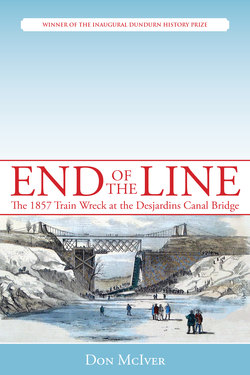Читать книгу End of the Line - Don McIver - Страница 6
На сайте Литреса книга снята с продажи.
PREFACE
ОглавлениеThe mid-nineteenth century arrival of the railways was transformative and traumatic. The way that people lived and worked, and how they interacted with the world outside their community, had probably never been more swiftly and permanently altered. The early railways brought efficiency and abruptly kickstarted industrial expansion. However, they also placed previously unheard of demands on the rudimentary engineering of the day. Each year the trains got faster and heavier, quickly exposing the crudeness of materials and the absence of scientific method in the design and maintenance of structures and equipment. When the early railways failed, they did so spectacularly.
Mass death was not uncommon in the mid-nineteenth century. Disease was badly misunderstood and, for the most part, remedies were rudimentary or simply unavailable. Cholera, exported from famine-swept Ireland and nurtured by weeks of inhuman seaboard conditions, swept through the new world, killing thousands. Survivors of everyday accidents endured hours or days of excruciating travel to reach medical care that consisted of little more than staunching, amputation, bed rest, and prayer. Shipwrecks were commonplace. Death tolls in the hundreds were surprisingly frequent. The newspapers contained many more stories of calamitous loss of life at sea than we read of disastrous air crashes today.
But death by train was something different. It was sudden — one minute you were riding comfortably, the next you were catapulted into the hereafter or trapped in excruciating pain. It was over almost before it had begun. Before there was time to understand what was happening, the train was wrecked and the lottery decided who walked away, who was injured, and who was past help. Unlike shipwrecks that occurred off remote coasts, railway accidents frequently happened in places where spectators and rescuers could congregate before the steam had cooled and the hot metal had stopped contracting. The victims were often local — friends and neighbours of the rescuers.
Railway death and injury was frighteningly modern. The railway changed the community, brought in new values and undermined the old. Trains brought in outside commercial and cultural influences, which challenged local interests. Probably the biggest challenge to conventional values of the time was railway companies running trains on Sundays.
Early railway disasters often took on almost mythical significance, ballads were written and legends born. The most likely to be etched into folk consciousness involved bridges. It is not hard to understand why. Trains meandering at an often sedate pace across the level countryside promised a sporting chance of survival when they derailed. Bridge wrecks offered less generous odds.
The story of the wreck of a Great Western Railway of Canada train that collapsed the wooden swing bridge over the Desjardins Canal in Hamilton, Ontario, and plunged to the canal’s frozen surface, killing sixty, is an archetype of the railway bridge disaster genre. The site of the accident — which was one of the most deadly experienced anywhere in North America at that time — is remarkably accessible today. Each year millions of travellers cross the short stretch of canal by superhighway, city street, and commuter train within view of the location.
The whole episode is rife with irony. Any major catastrophe spawns a host of might-have-beens — people who just missed being there, or those who just managed to be there and paid the consequence. But for high irony it is difficult to match the quirk of fate that had Samuel Zimmerman, the general contractor for that section of the Great Western, die in the accident. Compound that with the widely held view that Zimmerman delivered slipshod results at inflated prices and that many believed that he had skimped on the construction of the bridge itself. It wasn’t long before contemporaries like the cantankerous William Lyon Mackenzie were unctuously revelling in the notion that Zimmerman was literally hoist with his own petard! The second irony was that the bridge was, in fact, designed by a man of unquestioned technical merit who came to be viewed as the father of scientific bridge construction in North America — and he stood steadfastly behind the bridge’s integrity.
This chronicle details the precursors and immediate causes, as well as the subsequent impact on the community. Then goes further, to examine the lives and deaths of many of the passengers who represent a fascinating cross-section of a population that couldn’t have existed only a few years earlier and contrasts markedly with the stereotypical view of how Canadians lived in the 1850s.
